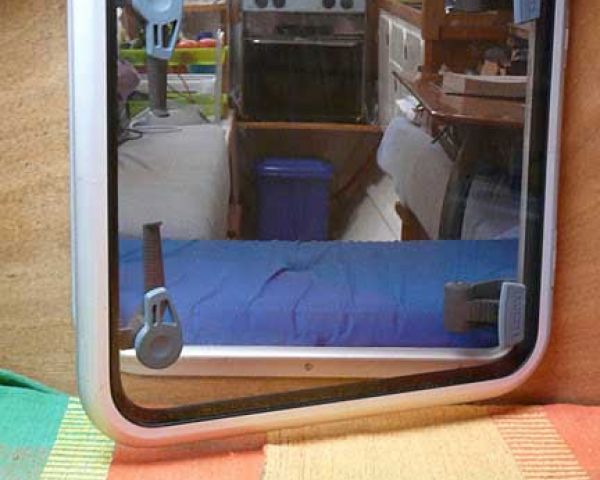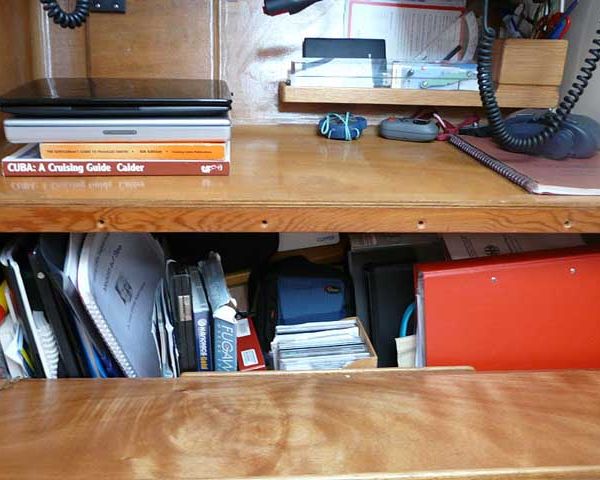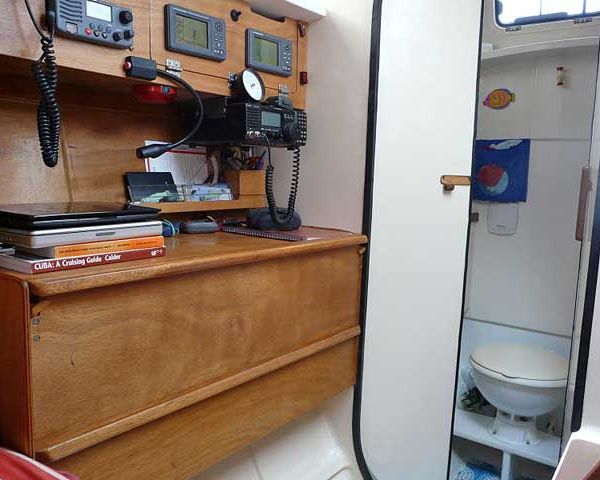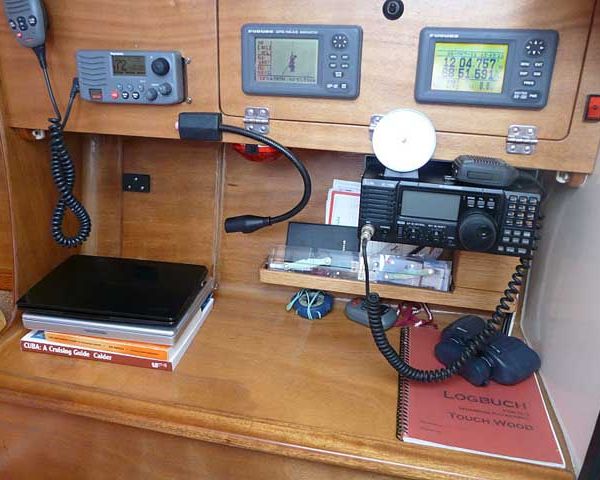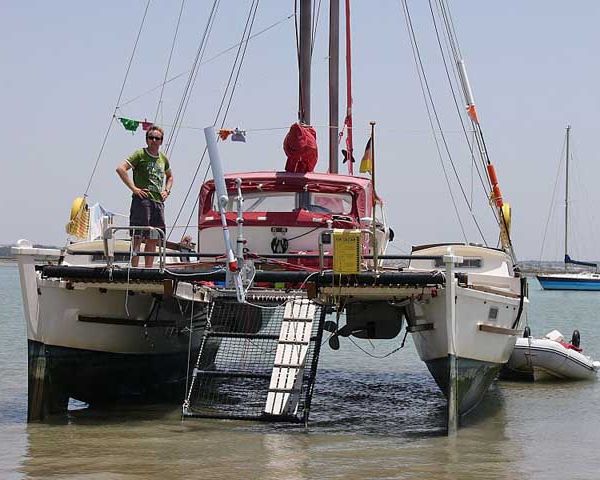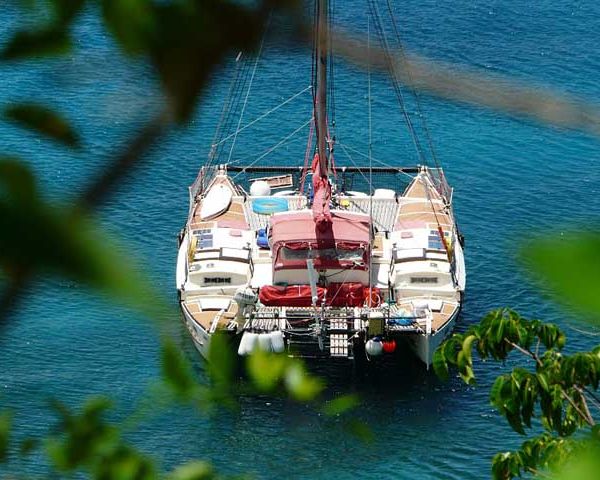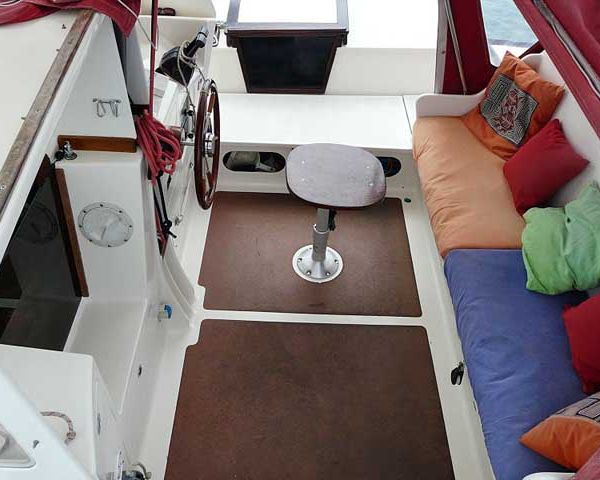-
NAVIGATION EQUIPMENT +
Instruments mounted in Cockpit:
Clipper Duet (Log & Depth)
Clipper Wind - new 2010
Clipper Compass
Clipper GPS Repeater
Mounting Bracket for Garmin GPS 72 (H/Held GPS)
Plastimo Steering Compass
Echomax "See me" active x-band radar warner (light & sound alarm) - new 2010
Instruments mounted above Chart Table in starboard hull:
Raymarine E55 VHF (DSCC) - new 2011
Icom marine band ssb transceiver, antennatuner and antenna.
Furuno GP32 GPS Furuno NX300 Navtex "Easy" AIS receiver - new 2010
Nav. lights: (Aquasignal) Tri-colour & All Round White Combined Port/Stbd.
Stern equipped with LEDs in 2010
-
SELF STEERING SYSTEM +
- Windpilot Pacific windvane - new 2008
- 2x Raymarine ST 1000 Tiller Pilot. Can be mounted to the windvane for steering in calms (motoring).
- 1x Raymarine ST 100 Tiller Pilot Remote Control - new 2010
-
MOORING & ANCHORING +
16 Kg. Delta Anchor on 45m. of 8mm Chain & 80m anchorplait.
Fortress (Alum.) on 10m of 10mm Chain & 100m anchorplait 20Kg.
Fishermans anchor. Two Bow Rollers (see mods.)
Loffrans 1000w Electric Windlass
Mooring lines: 4 x 15m Polyester 16mm
4 x 10m Polyester 12mm
2 x 20m Anchorplait
Hardwood Cleats on each Main Beam-end.
Handed S/S Fairleads on each Bow and Stern. -
SAFETY EQUIPMENT +
- 2 x Lifebuoys with Lights
- 1 x Danbuoy with Light
- 1 x MOB Recovery System
- 1 x "Zodiac" 4-person Liferaft (in need of service)
- 2x standard foam lifewests 150N (new 2007)
- 1x safety harness with line
- Rope Lifelines plus seafence with netting (added 2007, completely removable)
- 2 x Whale Bilge pumps 1 x 12V Bilge pumps (1100 GPH - new 2010) (all portable with long hoses and long cable for deployment where required, not fixed)
- Emergency Aerial for VHF
- Industrial-type UV resistant Safety Netting at Bow and on ramp (see mods.).
-
MASTS, SAILS and RIGGING +
Masts: - 6in. (150mm) dia. x 3mm wall thickness anodised Aluminium, made by Sailspar of Brightlingsea, Essex, UK.
- Shrouds and Forestay are all 6mm S/S wire, tensioned by lanyards.
- Working Rig (see mods.):
- 10oz. triple stitched sails by Arun as per sail plan. The jib is roller-furling.
- Cruising Chute by Jeckells.
- Halyards are 10mm. pre-stretched polyester, except storm jib halyard which is 8mm. Dyneema (we do not have a storm jib).
- Sheets are 10mm. Braid-on-braid polyester.
-
ENGINES +
- 2x 14hp (10.3Kw) Kubota twin cylinder with seawater cooling. Diesel Engines with FNR gearbox. Each engine has a separate (55 litre) S/S fuel tank.
- 140l spare fuel can held in jerry cans. - new 2010
- Last complete service of both engines, including new fuel injector, new seawater cooling system and new exhaust elbow was done in October 2011.
-
BATTERIES +
- 1 x 12V. 80 amp/h starter battery which also operates the electric windlass.
- 2 x 6V "Trojan" Deep Cycle batteries, wired in series to give 12V., Another pair 6V "Trojan" Deep Cycle batteries added in 2010 These are "golf-cart" type batteries and are 450 amp/hour (USA measurement) for navigation equipment and domestics.
- A 20 amp "Sterling" battery charger is permanently connected to the batteries.
- The starboard engine has a 65amp alternator connected with an external "Sterling" high power regulator connected to the domestic batteries. - new 2011
- The portside engine has a 70amp alternator connected to both the starter and domestic batteries via split diodes. - new 2011
-
ELECTRICAL SYSTEMS +
- 6 Solar Panels, two of which were added in 2010 (150w. total) are permanently connected to batteries via regulator/monitor (SunWare, Fox 350 - new 2010)
- One "Sterling" Digital quasi sin wave inverter 12V- 220V, 600W connected to the power system in both hulls. - new 2010
- All navigation equipment and the stbd. hull cabin lights and aux 12V socket are wired via a cct. breaker panel in the stbd. hull.
- The refrigerator, port hull cabin lights and aux. 12V. sockets are wired to a cct. breaker panel in the port hull.
Most cabin lights have been changed to LEDs (warm light) in 2010
Shore Power:
A connection socket in cockpit provides power, via RCB and cct. breakers, to the battery charger and to sockets in each main cabin. -
TANKS +
Fresh water: - 1 x 120l + 1 x 45l litre plastic tanks in port lazarette for galley.
- 1 x 65 litre plastic tank in Stbd. lazarette for heads.
- Further 200l fresh water can be stored in 10l jerry-cans. - new 2010
Waste:- 1 x 45 litre plastic tank in stbd. lazarette for shower sump.
- 1 x 120 litre plastic tank in stbd. lazarette for toilet waste.
- 1







